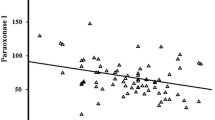Abstract
Serum paraoxonase (PON1) and antibodies to oxidized-LDL (anti ox-LDL) were measured in chronic renal failure subjects on renal replacement therapy such as hemodialysis (HD) peritoneal dialysis (PD) and transplantation (Txp). Paraoxonase activity was significantly lower in HD and PD group (P<0.001) than in control subjects. In transplant patients, paraoxonase activity was not significantly different from that of controls. Antibodies to ox-LDL was significantly higher in HD, PD and Transplant patients (P<0.0001) compared to control subjects. High titers of antibodies were observed in the HD group compared to the PD and Transplant subjects. A decrease in paraoxonase activity and high titers of Antibodies to ox-LDL in the dialysis group suggest a decreased cardio protective effect of HDL and enhanced risk of premature cardiovascular complications. Whereas in case of transplant subjects, there seems to be restoration of PON1 activity, but elevated levels of anti-oxLDL could still be a potential atherogenic factor. Hence, we propose that estimation of these two parameters can be used as a useful index to measure the cardiac risk in the above patient category
Similar content being viewed by others
References
Durrington, P.N., Arrol, S. and Mackness, M.I. (1991) Paraoxonase prevents accumulation of lipoperoxidase in low-density lipoprotein.FEBS Lett. 286, 152–154.
Mackness, M.I., Abbott, C.A., Arrol, S. and Durrington, P.N. (1993) The role of High density lipoprotein and lipidsoluble antioxidant vitamins in inhibiting low-density lipoprotein oxidation.Biochem. J. 294, 829–835
Watson, A.D., Berliner, J.A., Hama, S.Y., La Du, B.N., Faull, K.F., Fogelman, A.M. and Navab, M. (1995) Protective effect of high density lipoprotein associated paraoxonase.J. Clin. Invest. 96, 2882–2891.
Schiavon, R., De Fanti, E., Giavarina, D., Biasioli, S., Cavalcanti, G. and Guidi, G. (1996) Serum paraoxonase activity decreased in uremic patients.Clin. Chim. Acta. 247, 71–80
Gyorgy, P., Laszlo, A., Iidiko, S., Zoltan, B., Lajos, L. and Gyorgy, K. (1991) Serum paraoxonase activity changes in uremic and kidney transplanted patients.Nephron 83, 126–131
Witztum, J.L. and Steinberg, D. (1991) Role of oxidized low-density lipoprotein in atherogenesis.J. Clin. Invest. 88, 1785–92
Maggi, E., Bellazzi, R., Falaschi, F., Frattoni, A. and Perani, G., et al. (1994) Enhanced LDL oxidation in uremic patients: an additional mechanism for accelerated atherosclerosis?.Kidney Int. 45, 876–83
Haagen, L. and Brock, A. (1992) A new automated method for phenotyping arylesterase based upon inhibition of enzymatic hydrolysis of 4-nitrophenlyacetate by phenyl acetate.Eur. J. Clin. Chem. Clin. Biochem. 30, 391–395
Chait, A., Brazg, R., Tribble, D. and Krauss, R. (1993) Susceptibility of small, dense, low-Density Lipoproteins to oxidative modification in subjects with the atherogenic lipoprotein phenotype, pattern B.Am. J. Med. 94, 350–356
Aviram, M., Rosenblat, M. and Billecke, S. et al (1999) Human serum paraoxonase (PON1) is inactivated by oxidized low density lipoprotein and preserved by antioxidants.Free Radic. Biol. Med. 26, 892–904
Dantoine, T.F., Debord, J., Charmes, J.P. et al. (1998) Decrease of serum paraoxonase activity in chronic renal failure.J. Am. Soc. Nephrol. 9, 2082–2088.
Paul, J.L., Sall, N.D., Soni, et al. (1993) Lipid peroxidation abnormalities in hemodialysed patients.Nephron 64, 106–109
Cristol, J.P., Canaud, B., Rabesandratana, H., Gaillard, I., Serre, A. and Mion, C (1994) Enhancement of reactive oxygen species production and cell surface markers expression during hemodialysis.Nephrol. Dial. Transplant 9, 389–394.
Himmelfarl, J., Lazarus, M. and Hakim, R. (1991) Reactive oxygen species production by monocytes and polymorphonuclear leukocytes during dialysis.Am. J. Kidney Dis. 17, 271–276
Odetti, P., Garibaldi, S., Gurreri, G., et al (1996) Protein oxidation in hemodialysis and kidney transplantation.Metabolism 45, 1319
Cristol, J.P., Maggi, M.F., Vela, C., Descomps, B. and Mourad, G. (1996) Lipid metabolism and oxidative stress in renal transplantation: implications for chronic rejection.Transplant Proc. 28 (5),2820.
Inselmann, G., Blank, M. and Baumann, K. (1988) Cyclosporine A induces lipid peroxidation in microsomes and effects on active and passive glucose transport by brush border membrane vesicles of rat kidney.Res. Commun. Chem. Pathol. Pharmacol. 62, 207.
Serino, F., Grevel, J., Napoli, K.L., Kahan, B.D. and Strobel, H.W. (1994) Oxygen radical formation by the cytochrome p 450 system as a cellular mechanism for cyclosporine toxicity.Transplant Proc., 26, 2916.
Wang, C. and Salahudeen, A.K. (1995) Lipid peroxidation accompanies cyclosporine nephrotoxicity: Effects of vitamin E.Kidney Int. 47, 917–934.
Steinberg, D., Parthasarathy, S., Carew, T.E., Khoo, M.C., Witztum, J.L. and Beyong, C. (1989) Modifications of lowdensity lipoprotein that increase its atherogenicity.N. Engl. J. Med. 320, 915–924.
Esterbauer, H., Gebicki, J., Puhl, H. and Jurgens, G. (1992) The role of lipid peroxidation and antioxidants in oxidative modification of LDL.Free Radic. Biol. Med. 13, 341–390.
Author information
Authors and Affiliations
Corresponding author
Rights and permissions
About this article
Cite this article
Krishnaswamy, P.R., Rao, A., Murali, W. et al. Paraoxonase activity and antibodies to oxidized-LDL in chronic renal failure patients on renal replacement therapy. Indian J Clin Biochem 21, 173–176 (2006). https://doi.org/10.1007/BF02912937
Issue Date:
DOI: https://doi.org/10.1007/BF02912937




